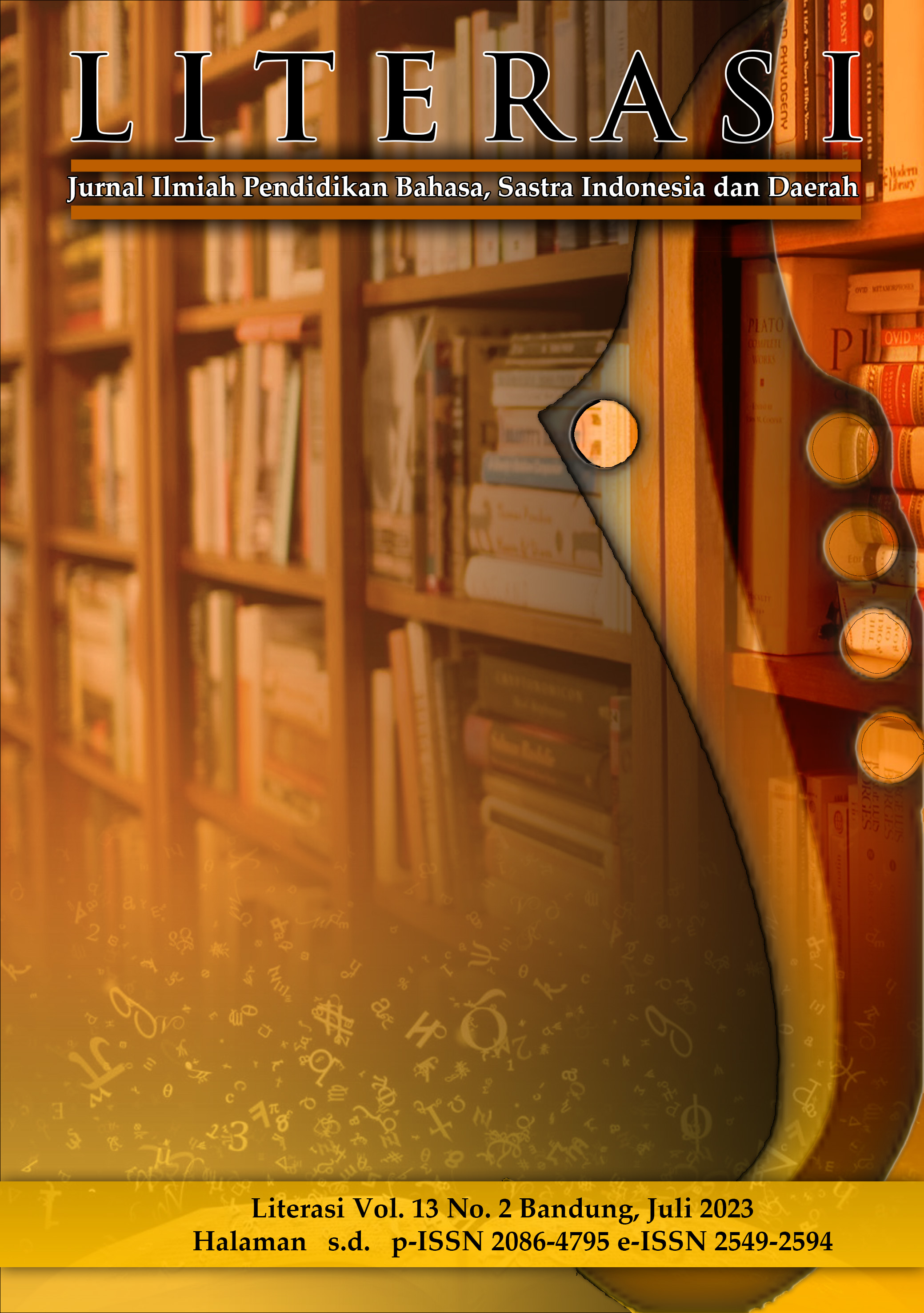EUFEMISME DALAM BERITA ELEKTRONIK TRIBUNJABAR.ID EDISI BULAN MEI 2021
DOI:
https://doi.org/10.23969/literasi.v13i2.6152Keywords:
euphemism, tribunjabar.id, electronic newsAbstract
The purpose of this study was to identify the form of euphemism, the function of euphemism, and the meaning of euphemism. The method used is descriptive qualitative research. The data in this study are in the form of words, phrases, sentences, or euphemistic expressions contained in the May 2021 edition of the electronic news Tribunjabar.id. In this study, there are 49 euphemistic data from the May 2021 edition of Tribunjabar.id as data from May 1 to May 31, 2021. In this study there are 3 data collection techniques, namely reading carefully and thoroughly every word, phrase, sentence, or expression of euphemism contained in the May 2021 edition of the Tribunjabar.id electronic news. The results of this study prove that there is the use of euphemisms in the Tribunjabar electronic news. en May 2021 issue, such as the use of words, phrases, meanings, and functions of euphemisms. (1) The euphemism of the use of words has 5 forms of data in the form of words and the euphemism of the use of words with affixes has 4 forms of data. (2) The euphemism of the use of the phrase has 4 forms. (3) The euphemism of the use of abbreviations in this section is clear and abbreviations are divided into two parts, namely initials and acronyms. The euphemism for the use of abbreviations contains 12 data, including 5 data in the form of initials. There are 7 data forms of acromine expression. (4) The euphemism of the use of loanwords contains 10 forms of data. (5) Euphemisms for the use of foreign terms in 6 forms of data. (6) Euphemisms using metaphors in 4 forms of data. (7) The euphemism of the use of 4 forms of data.
Downloads
References
Arifin Zaenal dan Hadi Farid. (2015). Seribu Satu Kesalahan Berbahasa Bahan Penyuluhan Bahasa Indonesia. Jakarta: Akademika Pressindo.
Chaer, Abdul. (2009). Pengantar Semantik Bahasa Indonesia. Jakarta: PT Rineka Cipta.
Chaer, Abdul. (2010). Bahasa Jurnalistik. Jakarta: PT Rineka Cipta
Daryanto. (2013). Menyusun Model Bahan Ajar untuk Persiapan Guru dalam Mengajar. Yogyakarta: Gava Media.
Infra Redaksi. (2013). EYD Ejaan Yang Disemprnakan Edisi Terbaru. Jakarta: Infra Pustaka.
Iskandarwassid dan Dadang Sunendar. (2016). Strategi Pembelajaran Bahasa. Bandung: PT. Remaja Rosdakarya.
Kosasih (2017), Buku Bahan Ajar Bahasa Indonesia Studi dan Pengajaran SMP/MTS kelas VIII. Jakarta: PT. Gramedia.
Kamus Besar Bahasa Indonesia. (1990). Jakarta: Balai Pustaka.
Narkubo Cholid. (2018). Metode Penelitian. Jakarta: PT Bumi Aksara.
Putrayasa Bagus Ida. (2010). Analisis Kalimat Fungsi, Katagori, dan Peran. Bandung: PT Refika Aditama.
Pribadi, (2019). Pengembangan Bahan Ajar. Tanggerang Banten- Indonesia: Universitas Terbuka.
Prastowo, Andi. (2015). Panduan Kreatif Membuat Bahan Ajar Inovatif Menciptakan Metode Pembelajaran yang Menarik dan Menyenangkan. Yogyakarta: Diva Press (Anggota IKAPI).
Romli M Syamsul Asep. (2020). Jurnalistik Online Panduan Mengelola Media Online. Bandung: Nuansa Cendekia.
Satori, Djaman dan Aan Komariah. (2012). Metodologi Penelitian Kualitatif. Bandung: CV Alfabeta.
Sutarman. (2017). Tabu Bahasa dan Eufemisme. Surakarta: Yuma Pustaka.
Winata, N. T. (2019). “Analisis kesalahan ejaan bahasa indonesia dalam media massa daring (detikcom)”. Bahtera Indonesia; Jurnal Penelitian Bahasa dan Sastra Indonesia, 4(2), 115-121.
Downloads
Published
Issue
Section
License
Copyright (c) 2023 Literasi: Jurnal Ilmiah Pendidikan Bahasa, Sastra Indonesia dan Daerah

This work is licensed under a Creative Commons Attribution 4.0 International License.
Hak cipta artikel yang diterbitkan di jurnal ilmiah dimiliki oleh penerbit, bukan penulis. Hal ini berkaitan dengan koordinasi hak akses untuk cetak ulang atau penggunaan lainnya. Dalam hal ini penerbit mempunyai keluluasaan untuk mempublikasikan artikel sesuai dengan kesepakanan Transfer Agreement (penyerahan hak cipta) antara penerbit dengan penulis.















